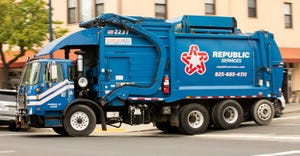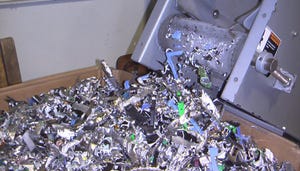Will Haulers Feel the Burn?
January 1, 2000
Aaron DeWeese
With the U.S. Environmental Protection Agency's (EPA), Washington D.C., medical waste incineration rule now officially in effect, hospitals across the nation are deciding whether to retrofit their existing incinerators or adopt new medical waste disposal practices. In all likelihood, many of the smaller hospital incinerators may shut down. Nevertheless, experts do not anticipate increased volumes of waste to haul or mega-incinerators to crop up the way Subtitle D regulations promoted the building of more regional landfills.
"We do not think that the total amount of medical waste in the market will change," says Frank ten Brink, Lake Forest, Ill.-based Stericycle Inc.'s chief financial officer. "If medical waste incinerators have to close, the waste will have to be absorbed by other treatment locations," which, he says could increase the medwaste disposal volumes for offsite companies.
The Rule The EPA rule, which went into effect Sept. 15, 1999, places emission limits on nine key pollutants from new and existing medical waste incinerators. The Earthjustice Legal Defense Fund (EJLDF), Washington, D.C., contends the EPA inappropriately did not base these limits on actual emissions data. Consequently, the U.S. Court of Appeals for the District of Columbia Circuit remanded the rule, and the EPA is reviewing the emissions limits and permit records database it used to draft its standard.
Nevertheless, "no matter what happens in the courts, everybody's supposed be online by 2001," says Tom Herbert, chairman of Medical Waste Institute, a division of the Washington, D.C.-based National Solid Waste Management Association (NSWMA), and chairman of the Medical Waste Incinerator Task Force for NSWMA. While the court ruling may have left open questions on acceptable limits, states still are required to submit their compliance plans to the EPA by 2001. If a state fails to submit a plan, it will be subject to the EPA's federal plan.
"Some states probably will wait and adopt the federal plan so they don't have to waste time with public meetings and staff time," says Herbert, also engineering manager for American Waste Industries Inc., Norfolk, Va., which owns and operates three incinerators and two autoclave units. State plans must be at least as stringent as the federal plan, which will require hospitals to retrofit existing incinerators or select alternative disposal methods such as pre-treating medical waste with autoclaves or microwaves.
Fewer Incinerators The EPA anticipates the high costs of compliance will force an estimated 50 percent to 80 percent of the nation's estimated 2,400 medical waste incineration units to cease operations. New large incineration units are not expected.
"Personally, I would find it unlikely for there to be many new incinerators," says Jane Rubinstein, director of environmental affairs for Biosystems, Farmingdale, N.Y., and current Medical Waste Institute board member. "Incinerators are the most costly disposal option. For hospital incinerators, it's a decision matrix."
"I don't think there are going to be a lot of new incinerators," Herbert agrees. "The standards are stricter for new incinerators. They're just not going to provide a lot of return on the investment considering the regulations. There's not enough medical waste out there."
Some densely populated areas such as New York might be able to generate enough medwaste to financially justify building a new incinerator. But for most areas, long-distance hauling costs combined with exorbitant capital expenditures make siting a new facility nearly impossible, Herbert says. "[American Waste Industries] hasn't identified the medical waste incinerator rule as something that will send more waste to us."
Despite having fewer incinerators, there are several reasons why medwaste is not hauler friendly. First, the Department of Transportation (DOT) Research and Special Programs Administration (RSPA) is considering adopting international standards for medwaste transportation that may result in stricter hauling regulations. [See "Medwaste Regulations Go Global," Waste Age May 1999, page 172.]
Second, "you can't haul bulk medical waste very far," says Robert Lewis, CEO and chairman of Medical Waste Corp. of America, Westchester, Pa., the parent company of both Sterile Technology Industries Inc., a regulated medical waste (RMW) autoclave manufacturer, and Bridgeview Inc., a RMW hauling and disposal company. "We believe [RMW disposal] is more of a regional business. You can't haul medical waste a 1,000 miles," he says.
Will Hauling Remain Regional? Indeed, the RMW disposal industry primarily has been regional up until now, Lewis says. However, a change may be in store with Stericycle's recent acquisition of Houston-based Browning-Ferris Industries' medical waste disposal division.
With a network of 36 treatment locations, "Stericycle is the only nationwide medical waste service company," Brink says. "We can and are working with companies to standardize medical waste treatment throughout the U.S."
Medical Waste Corp.'s Lewis actually welcomes the change. The RMW disposal industry has been too fragmented for too long, which, in turn, has diluted the industry's ability to be competitive, he says. With Stericycle's acquisition, Lewis predicts disposal costs to increase slightly. But he hopes the acquisition will spur more research and development and capital improvements, which ultimately will work in the customer's favor.
Then, the burning questions become: can regional haulers can stand up to a national powerhouse, and will they benefit from the increased volume of RMW being hauled as smaller incinerators shut down?
Haulers already have been preparing to transport more RMW, says Jane Rubinstein, NSWMA's senior manager of waste programs and research. "This is an issue the industry has been preparing for years," she says. "There is enough commercial disposal capacity to address the needs of medical waste disposal."
However, hospitals may not be prepared to handle increased volumes of medwaste, and haulers may not necessarily see an increase in more waste - hospitals may choose other handling options.
One drawback to hauling is that properly disposing of once-burned medical waste will require additional training, Rubinstein says. This burden of training hospital staff on proper disposal procedures is likely to fall on the hauling industry, Lewis says. However, because there is no universal packaging standard currently in place, RMW may not always be recognizable to waste handlers. New disposal techniques and requirements will have to be learned. And with more medical waste being hauled, more handlers are at physical risk from sharps and other biohazardous materials.
To complicate matters further, RMW treated in autoclaves can be processed as regular commercial waste, but if sharps have not been removed or ground thoroughly, the risks of waste handlers being injured will increase. Consequently, segregating sharps from other medical waste to prevent handling-related injuries and to divert metal objects from damaging autoclave grinders will become important.
"Some haulers may provide customers with more education on proper waste disposal and how to package materials," says Alice Jacobsohn, manager of waste programs for the NSWMA. "Some customer relations are going to come into play."
Hauling medwaste also may not be attractive to some communities. For many hospitals, public relations issues will play a crucial role in deciding future RMW disposal plans, Jacobsohn says. Red bag waste hauled through town may be as unpopular as building an incinerator. One advantage to incineration was that medwaste's ash is unrecognizable.
If you have an incinerator, you have to decide whether you will replace it and what you will replace it with, Jacobsohn says. "The impacts of the incinerator rule are really with the technology itself."
Hospital Options Instead of offsite hauling, some hospitals may opt for autoclaves, steam sterilization units that allow RMW to be disposed of like any other commercial waste. With internal grinders, autoclave-treated waste is virtually unrecognizable, which in turn eliminates potential public concerns. However, hospitals generating less than 200,000 pounds per year of RMW will probably opt to tape, box and truck their waste in reusable containers because autoclaves are designed to handle larger volumes of waste.
Nevertheless, "there is a plethora of alternative on-site technologies available that will be economically viable options where now there are incinerators," Herbert says. "Autoclaves, chemical treatment systems - these are things that are able to be scaled into a hospital environment."
"For major medical centers, there are compelling economic reasons for doing onsite processing," Medical Waste Corp.'s Lewis adds. "The large medical institutions will buy their own equipment. They bought incinerators before. They'll buy alternative systems now."
While every state has some form of incineration regulations, alternative treatments, such as the autoclave, are approved in most states, and no national standards exist, which further detracts from hauling, Rubinstein notes. For example, some states classify autoclave treated waste as medical waste while others classify it as commercial. Some states even allow untreated medical waste to be disposed of in commercial facilities.
"Some alternative technologies are going to become less of an alternative and more of a standard," says NSWMA's Jacobsohn, who predicts the medwaste industry to consolidate similar to the healthcare industry.
"Most medical waste firms now are smaller, privately owned companies. Some are going to play out and become less viable. [The medical waste industry] still is relatively new. Some are quite legitimate businesses, and some are not as fully compliant and they are going to start disappearing."
Although you can't predict the future, as with any new EPA ruling, some companies will prosper and others will close along with the era of the small hospital incinerators.
The Department of Transportation (DOT) Research and Special Programs Administration (RSPA) is considering revising its standards for infectious substances and announced an advance notice of proposed rule making, called "Hazardous Materials: Revision to Standards for Infectious Substances and Genetically Modified Micro-organisms." [See "Medwaste Regulations Go Global," Waste Age, May 1999, page 172]
Part of the proposed rule involved changing the definition of infectious waste to follow World Health Organization (WHO), Geneva, Switzerland, risk groups, which define how to segregate, package and transport infectious substances and regulated medical waste (RMW). Currently, the United States uses the Centers for Disease Control and Prevention, Atlanta, Ga., biohazard safety levels as guidelines.
According to Alice Jacobsohn, senior manager for waste programs and research with the National Solid Waste Management Association, Washington, D.C., one of the goals is to create an international standard so U.S. companies can be more competitive globally. This is great news for the pharmaceutical industry, which is regulated by the same DOT standards as medical waste, she says. Pharmaceutical companies routinely transport products across national borders. In contrast, regulated medical waste rarely, if ever, crosses international borders.
"What the DOT is looking at now is what waste is going where," Jacobsohn says "Risk group one is less stringent than risk group four. The packaging is different. The main impact for medwaste haulers is going to be retraining for the new definitions and new packaging. There's going to be some catch up time for training. Hopefully, DOT will do a significant outreach program."
"We're ready for it now," says Robert Lewis, CEO and chairman of Medical Waste Corp., Westchester, Pa., the parent company of Bridgeview Inc. and Sterile Technology Industries medwaste companies. "We've been working with the DOT for the last two years on bulk hauling systems."
However, whether other medical waste hauling companies are prepared for the potential impact of the proposed DOT ruling combined with the EPA new ruling governing medical waste incinerators is yet to be seen.
The new U.S. Environmental Protection Agency (EPA), Washington, D.C., ruling places emission limits on nine key pollutants from new and existing medwaste burners - including dioxins, furans, particulates, acid-gases such as hydrogen chloride and sulfur dioxide, carbon monoxide, nitrogen oxides and three heavy metals: mercury, lead and cadmium.
The rule, which requires incinerator owners and operators to determine whether to retrofit existing incinerators or turn to alternative medwaste disposal options such as autoclave and microwave sterilization systems, went into effect on Sept. 15, 1999. All states must submit compliance plans to the EPA by Sept. 15, 2001.
In the meantime, the agency is reviewing the extensive database of emissions limits and permit records it used to draft its standard following the U.S. Court of Appeals for the District of Columbia Circuit remanding of the rule. The court decision was based on a lawsuit filed by Earthjustice Legal Defense Fund (EJLDF), Washington, D.C., which contended the EPA inappropriately based some emission limits on maximum achievable control technology (MACT) floor permit data, rather than on actual emissions data. EJLDF argued that EPA failed to sample enough incinerator units to produce a figure that is equal to the best performing 12 percent of incinerators. [See "Will EPA's Medwaste Rule Burn Up Incineration?" Waste Age, September 1999, page 104].
You May Also Like


